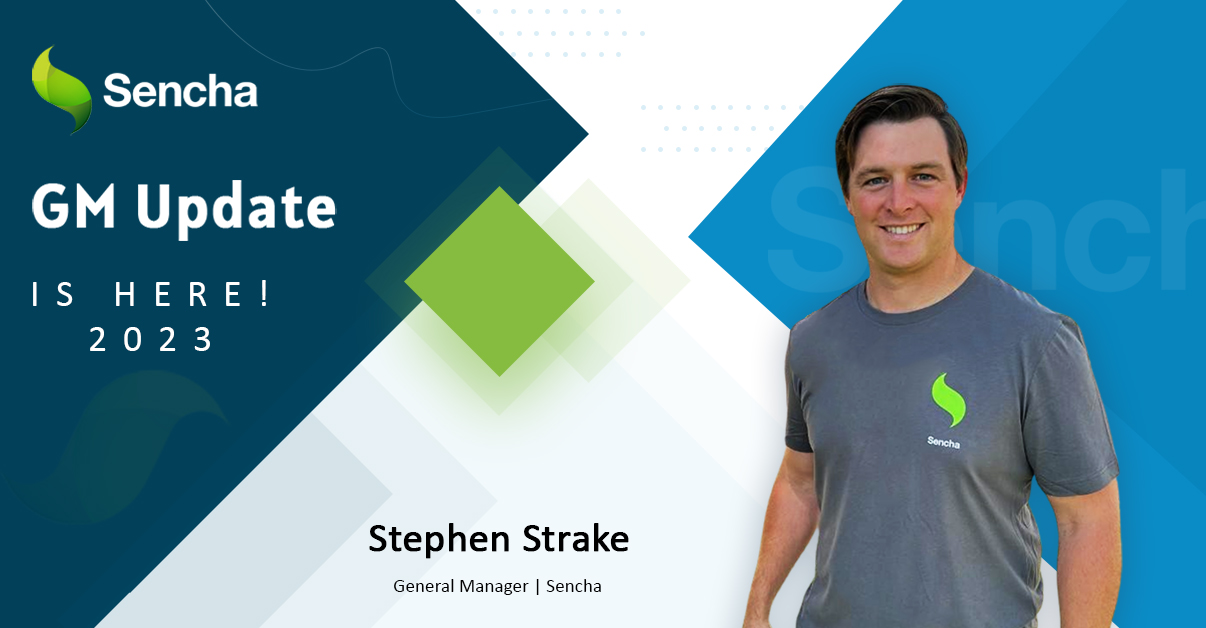Highlights of Virtual JS Days 2024
Highlights of Virtual JS Days 2024
From February 20-22, 2024, we held the third Virtual JavaScript Days. It featured many sessions on a wide array of JavaScript topics. They ranged from Sencha’s latest product, ReExt, and Rapid Ext JS. They also included the newest examples in JavaScript.
This conference covered many topics. Marc Gusmano, a Sales Engineer at Sencha, led one standout session. Marc gave a detailed presentation on Sencha’s latest product, ReExt. He provided attendees with a full understanding of its features and benefits.
The conference started with an inspiring keynote. It was from Stephen Strake, General Manager of Sencha. He shared insights about the company’s vision for the future. It was an exciting event. It brought together JavaScript developers, engineers, and enthusiasts from all over the world. It provided a unique chance to learn about the latest in the JavaScript ecosystem.
Keynote Highlights
Stephen Strake, Sencha’s General Manager, led the first session of JS Days 2024. In this session, Stephen shared the keynote themes.
He delved into JavaScript’s rich history and evolution. He then shed light on the challenges JavaScript faced early on. He recounted how compatibility issues with different browsers threatened to stop its adoption. “ECMA standardized JavaScript. This made it easier for developers. They could write code that worked in all browsers,” Stephen explained. He underscored the pivotal role of this effort in ensuring JavaScript’s longevity.
Looking ahead, Stephen painted an exciting picture of the future of web development. He said new tools like Rapid Ext JS and React ReExt are set to revolutionize the industry. Rapid Ext JS allows for faster website creation with less code. “React ReExt combines two popular technologies. It creates seamless web experiences,” he said. This left the audience inspired and eager to explore these new technologies.
Stephen then passed the baton to Marc Gusmano. He discussed Sencha’s new product, ReExt.
How to use Ext JS components in a React Application – ReExt
Marc’s presentation discusses integrating Sencha Ext JS components into React apps. The tool called React ReExt makes this possible. It starts by highlighting why to choose React. It emphasizes its versatility and support from developers. Then, he introduces React ReExt. It lets you use Ext JS components in React projects. This tool makes the process easier. It provides a single part that is reusable. It works with many build environments. It allows developers to use existing Ext JS code in their React applications. They can do this without needing to make big changes to React or the Sencha Ext JS SDK.
React ReExt is a simple, flexible solution. It offers benefits like compatibility with the latest versions of React and Ext JS. It also supports many licensing options. It works with different build environments. Marc also gave practical examples and instructions for starting with React ReExt. This included installing npm packages. It also involved setting up components. It used the ReExtData.json file for configuration. Developers want to use Sencha Ext JS components in their React apps. They can refer to the presentation as a guide.
Unlock the Power of ChatGPT to Master JavaScript Coding (Ext JS Projects)
Andres Villalba, a Sencha Sales Engineer, led the next session. It will explain how Chat GPT can help Ext JS developers make apps. It begins with a list of prerequisites, including Sencha cmd, Sencha Ext JS 7+, and a Chat GPT account. The latest version of Ext JS on Chat GPT is 7.3.0. Developers are encouraged to start from an Ext JS template. They can choose between Modern and Classic toolkits. It also finds common mistakes in Chat GPT. These include wrong namespaces, missing store names, and incomplete arrays.
The presentation then delves into how Chat GPT can aid Ext JS developers in various tasks. This includes creating data, screen layouts, and storing classes from JSON objects. It also includes making grids, charts, and forms. The document provides detailed steps. It shows how to build a project. You can use the Professional and Enterprise versions or you can use the trial version to try it yourself.
Create a Kanban Board Component
During the session, Rafael Méndez, a software developer, presented on creating a Kanban Board Component. He introduced Custom Components. He emphasized their ability to suit specific needs. The presentation covered two main types of component customization. The first is enhancing existing components. The second is creating composite custom components. The steps for creating a custom component were outlined it include: understanding requirements. Extending the framework’s base parts, Using configurations. And creating custom events and methods. You need Sencha Cmd, Sencha Ext JS 7+, and Visual Studio Code to make a Kanban Board. The tutorial demonstrated how to build a Kanban Board using Ext JS. The session concluded with a Q&A session for further clarification.
Day 2 Sessions
Building Ext JS applications with Sencha’s newest tool: Rapid Ext JS
The second-day session of the presentation focused on Rapid Ext JS, presented by Marc Gusmano, a Sales Engineer at Sencha. Rapid Ext JS is a Visual Studio Code extension. It allows for the visual construction of Ext JS applications. It has drag-and-drop support for components. Compared to Sencha Architect, Rapid Ext JS does not utilize metadata, is hosted as a VS Code extension, and employs @sencha/ext-gen. We discussed the installation process. We also talked about key features like view modes, the new view generator, Sencha toolbox, and component hierarchy. We also covered the documentation resources for further guidance. This session provided valuable insights. It covered using Rapid Ext JS for quick app development.
Using Google Firebase to Authenticate Your JavaScript App
The next presentation focuses on using Google Firebase for authentication in JavaScript applications, presented by Wemerson Januario, a Developer Advocate at Sencha. It outlines Firebase’s overview. This includes its features. They have easy integration. They have many authentication methods. They also have security, scalability, real-time updates, and work on many platforms. It shows how simple it is to set up Firebase projects. And how to configure them in JavaScript apps. The demo shows a Sencha Ext JS app with Firebase authentication. It also explores the app’s source code.
Mastering Ext JS ViewModel: Best Practices for Effective Implementation
The presentation provides a foundational overview of ViewModel in Ext JS, focusing on the Model-View-ViewModel (MVVM) architecture. It delves into the ViewModel’s significance in separating concerns and improving code maintainability, highlighting its role in facilitating two-way data binding for synchronization between the view and data model. Additionally, the presentation covers strategies for managing data loading, API requests, and other asynchronous tasks effectively within the Ext JS framework.
Day 3 Sessions
How to index Storyblok content in Apache Solr and search it with Nuxt3
This exciting session outlines the process of indexing Storyblok content in Apache Solr and searching it with Nuxt. Storyblok is a Headless CMS. It has features like a live preview in its visual editor, content modeling, custom workflows, plugins, a digital asset manager, user roles, localization, and an API-first approach. The website is built using Nuxt/Vue and deployed with Cloudflare Worker, while Apache Solr serves as an open-source enterprise search platform based on Apache Lucene. Solr provides features. These include document storage with schema and dynamic fields. Also, language analytics, facet search, and synonyms. Plus, stopwords, boosting, spelling suggestions, “more like this” suggestions, and a Search/Indexer API with webhooks for indexing.
Role of JavaScript in the Modern Workplace
The next session explores the role of JavaScript in the modern workplace. It highlights its evolution, how common it is, and its uses on many platforms. JavaScript has moved from being a browser-based language. It has expanded into server-side and desktop applications. Technologies like Node.js and Electron helped with this. It’s the top language for UI development and full-stack apps. Examples range from automating physical processes to scripting in Microsoft and Google apps. The session emphasizes JavaScript’s role in automation. It also covers its role in low-code app development and its integration with AI. This underscores its importance for both pro developers and citizen developers. It also addresses the importance of teaching JavaScript to students. It suggests that knowing JavaScript can boost productivity and create job opportunities.
TypeScript 101: Increasing productivity and Developer Experience
The final presentation by Luciano dii Souza, also known as OPrimoDev, introduces TypeScript 101, emphasizing its role in increasing productivity and developer experience (DX). It outlines the basic requirements for using TypeScript. These include Node.js and a code editor like Visual Studio Code. It compares JavaScript (JS) and TypeScript (TS). TS was created by Brendan Eich in 1995. It enhances JS with added features. TypeScript has benefits. These include catching errors early and boosting productivity. It also has a large community. It enables gradual adoption. The presentation then delves into TypeScript’s features such as primitive types, object types, function types, union and intersection types, literal types, any and unknown types, and tuples types, providing examples within Visual Studio Code. It concludes by discussing tools for enhancing the developer experience and providing resources for further learning, with Luciano dii Souza inviting questions and interaction through his social networks.
Key Takeaways
Over 2,800 developers globally attended the JS Days conference. The conference aimed to give them info on the latest JavaScript tools and product demos. It also covered Sencha’s key products: ReExt and Rapid Ext JS.
Conclusion: See you next year!
Like all the previous JS Days events, the Virtual JS Days 2024 was also a great success. Top JavaScript engineers, Sencha MVPs, and developers took part in the sessions. They also did the Q&A sessions. Sencha hinted at the conference about possible talking points for the next one. They sound exciting.
Sign Up for Ext JS today – Get the Best JavaScript Framework for Your Enterprise.


Highlights of Virtual JS Days 2024 From February 20-22, 2024, we held the third Virtual…

We are past the midpoint of 2023 and we are very proud of what we…

Welcome to our Developer Spotlight Series, where we showcase the remarkable talents and achievements of…



 Rapid Ext JS (beta)
Rapid Ext JS (beta)













